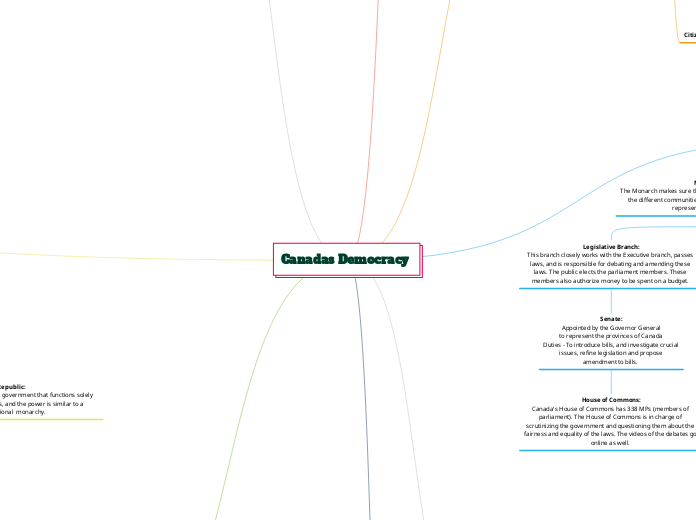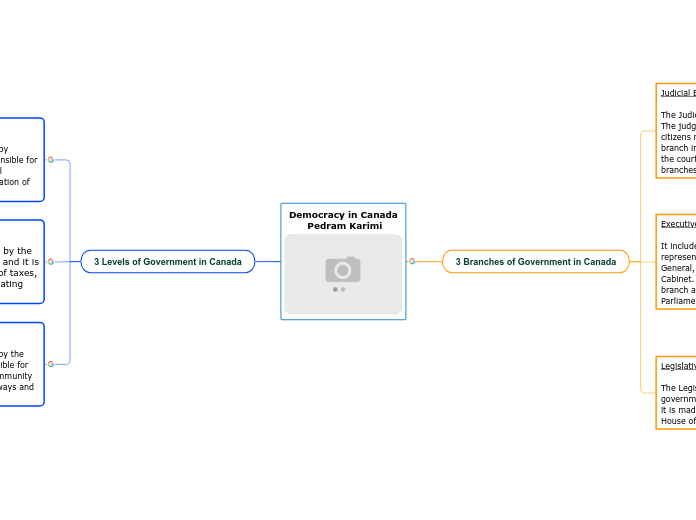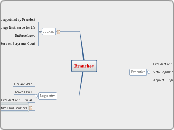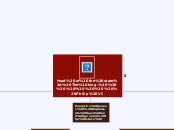Canadas Democracy
Types of Democracy
Representative Democracy
Parliamentary:
Citizens only get to vote for their
local representative. After the voting
the leader of the party with
the most seats becomes the Prime
Minister (Example: Canada)
Presidential:
Citizens get to vote for both their
president and local representative
(Example: The United States)
Constitutional Monarchy
Constitution
Constitutionnel monarch
(Representation by the Governor General)
Parliament:
Power + Design making reside
with the elected government
Federal State
Provincial
Municipal:
The municipal government follows the
laws that are described by the provincial
government not from the constitution
National
Government Types
Democracy:
Nation ruled by the citizens
Republic:
A democratic republic is a government that functions solely based on charter rights, and the power is similar to a Constitutional monarchy.
Constitutional Monarchy:
Rule by all
(power shared by citizens)
Leaders are elected and everyone has
access to leadership
Citizens can protest they also have the power
and can engage in other ways
Everyone is accountable for the same laws
(including the political leaders)
Consitution limits the power of the leader
Indivuals have the civial and political rights
and are protected by them.
Connection to Canada:
However, the crown’s power is still limited due to British traditions and the Canadian Constitution.
After getting inspired by the British, the Fathers of Confederation made Canada a constitutional monarchy, meaning that the King or Queen of Britain was Canada’s head of state and the final authority to make any changes to the laws.
Autocracy:
Umbrella term for rule by a
few without restrictions
(Example: Hitler)
Absolute Monarchy:
Rule by one (Single Dictator)
Citizens have limited to no involvement
Political opposition is limited
Rule of Law does not exist in these nations
(people in power do not follow the laws)
These nations do not have a constitution.
(the dictator simply changes laws)
Restricted civil and political rights
(No independent media. Media in favour
of the dictator)
Oligarchy:
Rule by one (Single Dictator)
Citizens have limited to no involvement
Political opposition is limited
Rule of Law does not exist in these nations
(people in power do not follow the laws)
These nations do not have a constitution.
(the dictator simply changes laws)
Restricted civil and political rights
(No independent media. Media in favour
of the dictator)
Dictatorship:
Rule by one (Single Dictator)
Citizens have limited to no involvement
Political opposition is limited
Rule of Law does not exist in these nations
(people in power do not follow the laws)
These nations do not have a constitution.
(the dictator simply changes laws)
Restricted civil and political rights
(No independent media. Media in favour
of the dictator)
Founding Peoples, Agreements, and Documents
Treaties with Indigenous People
There have been many treaties over the years with the Indigenous peoples. With taking their land and introducing many harsh places such as the residential schools, the Aboriginal peoples in Canada have been through it all. Here are some listed treaties between the Canadians and ingenious communities. We also have to remember that Canada was not always independent, and the British signed many treaties as Canada was one of the British Colonies.
Williams Treaties (1923)
The purpose of this treaty was for the surrender of many large portions of land that the Indigenous communities still had.
Treaty was signed by Canadian federal representatives and many indigenous communities
The Numbered Treaties (1871-1921)
There are 11 numbered Treaties in total
The purpose of this treaty was to promise Indigenous communities reserve lands, annuities and other rights to do their daily tasks on Crown Lands in exchange for their aboriginal title.
Treat was signed by the Canadian government and Indigenous peoples in parts of many provinces.
Douglas Treaties (1850-1854)
The purpose of this treaty was to protect Aboriginal peoples fishing and hunting rights in given up territories.
Treaty was signed by the British Colonists and 14 First Nations on Vancouver Island.
The Robinson-Superior and Robinson-Huron Treaties (1850)
This treaties key points also overlap with the Douglas Treaties
The purpose of this treaty was to establish a healthy relationship between the First Nations and Europeans on mutual bases of respect for one another.
Treaty was signed by British Crowns Monarch and the Ojibwa chiefs at Sault Ste. Marie, Ontario
Peace and Friendship Treaties (1725-1779)
The purpose of this treaty was as the name suggests to prevent war between the British and these First Nations groups.
Treaty was signed by the British and Mi'maq, Maliseet and Passamaquoddy First Nations in Nova Scotia
Treaties of Peace and Neutrality (1701-1760)
The purpose of this treaty was to end the friendship between the French and Aboriginal peoples
Treaty was signed by the French and Aboriginal peoples in St. Lawrence Valley.
Canadian Constitution
Constitution is the beliefs and values a country holds. Canada strongly believes as it is a democratic nation. Canada has a Charter of Rights and Freedoms to outline its constitutional beliefs. It was introduced in Canada in 1982. It is the supreme law of Canada. Every law had to pass this charter to determine its fairness. Here are the main points it outlines:
Indigenous peoples’ rights
Canada's multicultural heritage
Minority language education rights
Equality rights for all
The official languages of Canada
Legal rights (life, liberty, and personal security)
The right to live and seek employment anywhere in Canada
Fundamental Freedoms and Democratic rights
British North American Act (1967)
It negatively affected the Indigenous peoples in Canada as well. They lost their states and became citizens like the average European, and they lost the rights that they had gained as well because now all the citizens were equal.
Section 91 of the British North American Act transferred the relationship between the First Nations and the British to the Canadian government without asking the First Nations, making it a huge problem.
The British North American Act also was one of the big steps Canada took to be an independent nation separate from the British.
It established federalism in Canada which means that the political power was divided up equally between the parliament and provincial legislatives.
It was a new act that allowed the Canadian territories to have a voice allowing them to have a seat in the Canadian senate as well as the Canadian House of Commons. Canada had both since it has a parliamentary democracy.
Ontario, Quebec, Nova Scotia, and New Brunswick made up the new nation giving it the name “Dominion of Canada.”
The British North America Act was effective on July 1, 1867.
Queen Victoria signed this act on March 29, 1867, but it was ineffective until July 1867.
The London conference was held before the British North America Act was signed. At this conference, the provinces came together to discuss the final details of the act.
Sources
Study.com, 2022, study.com/learn/lesson/what-is-freedom-of-the-press-history-examples.html.
Heritage, Canadian. “Guide to the Canadian Charter of Rights and Freedoms.” Www.canada.ca, 23 Oct. 2017, www.canada.ca/en/canadian-heritage/services/how-rights-protected/guide-canadian-charter-rights-freedoms.html#.
https://www.international.gc.ca/world-monde/issues_development-enjeux_developpement/human_rights-droits_homme/advancing_democracy-avancer_democratie.aspx?lang=eng
“Freedom of the Press.” Wikipedia, 22 Mar. 2023, en.wikipedia.org/wiki/Freedom_of_the_press#:~:text=In%202022%2C%20the%20eight%20countries.
content, Insert the English name of the entity responsible for making the. “Insert the English Title.” Lobbycanada.gc.ca, lobbycanada.gc.ca/app/secure/ocl/lrs/do/clntOrgCrpLstg?pfx=A.
Canada, Government of Canada; Indigenous and Northern Affairs. “The Numbered Treaties (1871-1921).” Www.rcaanc-Cirnac.gc.ca, 15 Feb. 2013, www.rcaanc-cirnac.gc.ca/eng/1360948213124/1544620003549#. Accessed 10 June 2023.
Stress points in Canadian Democracy
Canada is really advanced in its democracy, views and laws.
Canada is looking forward to strengthen its democracy by:
youth civic engagement
promotion and protection of human rights
free, fair, and inclusive electoral processes
independent media and Internet freedom
making a more resilient and active civil society
Government Institutions
Judicial Branch:
The judicial branch is separate from the legislative and executive branches. The primary role of this branch is to solve issues related to the law.
Supreme Court of Canada:
The supreme court of Canada is the highest and has the most power. It uses laws and jurisdictions for cases and abides by the laws of Quebec and the rest of Canada's provinces.
Lower Courts:
The lower courts help deal with more minor issues. These issues can range from road issues, accidents and family affairs.
Monarch:
The Monarch makes sure the laws and rules show unity among the different communities in Canada. (Governor General represents the Monarch)
Executive Branch:
This branch delivers various programs and services to the public after the legislative branch approves them.
Prime Minister:
The Prime Minister holds the role of being responsible for the policies and laws that the government makes.
Cabinet:
The cabinet's prominent role is to advise the prime minister, and also deal with other controversial issues.
Legislative Branch:
This branch closely works with the Executive branch, passes laws, and is responsible for debating and amending these laws. The public elects the parliament members. These members also authorize money to be spent on a budget.
Senate:
Appointed by the Governor General
to represent the provinces of Canada
Duties - To introduce bills, and investigate crucial
issues, refine legislation and propose
amendment to bills.
House of Commons:
Canada's House of Commons has 338 MPs (members of parliament). The House of Commons is in charge of scrutinizing the government and questioning them about the fairness and equality of the laws. The videos of the debates go online as well.
Insitutions and Democracy
Citizen Groups (advocacy/lobby groups)
Lobbying is the attempt by specific individuals to influence the government's decisions. Lobby groups use lobbying and media to challenge the law in court to influence the decisions. Some examples of advocacy groups in Canada are:
The Mining Association of Canada
Lobbied for environmental assessment regulations
Chicken Farmers of Canada
Lobbied for meat inspection regulations
Canadian National Railway
Lobbied for railway noise control
Canadian Bankers Association
Lobbied for accounting laws
Bus rider union (Vancouver)
Lobbied for more busing
Citizens
Citizens play a massive role in democratic nations in oppose to autocratic nations. Citizens hold the power to put someone in authority or take them out in democratic nations. Suppose the citizens in a democratic government see an unfairness bias in laws. In that case, lobby groups may decide to protest and fight for their rights in the country by overturning the law or opposing making specific changes so that there is no more bias.
Democratic Nations
New Zealand
Norway
Switzerland
USA
Canada
Autocratic Nations
Italy = during Benito Mussolini times
Germany = during Adolf Hitlers time
Free and fair elections
Free and fair elections are elections that are held with no bias. In Canadian History, there have been many instances of partisan elections that favoured one party, for example, the federal election in 2011. Free and fair elections lead up to the correct amount of voters voting.
Free and independent press
A free and independent press is free media, in other words. It is the freedom to give valuable information to the public for them to make meaningful decisions. An example of a free and independent press is when elections happen; news reporters report news that can either make you vote for a particular party or not. The government does not restrict this type of media, and it's free for all.
Some countries that do not have the least press freedom:
Iraq
Iran
Cuba
China
North Korea
Some countries that have the most press freedom:
Costa Rica
Ireland
Finland
Sweden
Denmark
Factors that Shape Canadas Democracy
Values, Beliefs, & Ideologies
Technology
Global Forces
Geography
Economics
Diverse Culture









